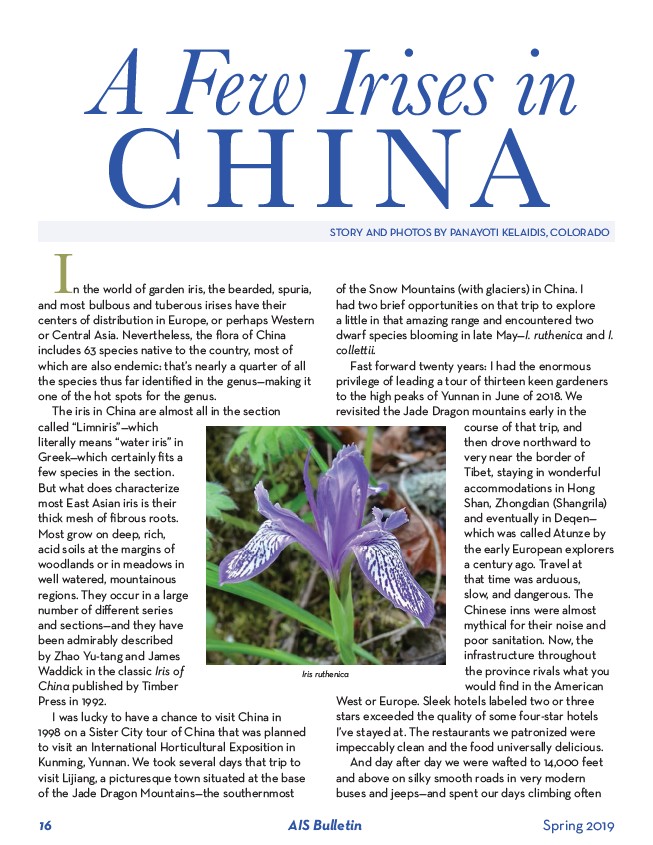
A Few Irises in
CHINA
In the world of garden iris, the bearded, spuria,
and most bulbous and tuberous irises have their
centers of distribution in Europe, or perhaps Western
or Central Asia. Nevertheless, the flora of China
includes 63 species native to the country, most of
which are also endemic: that’s nearly a quarter of all
the species thus far identified in the genus—making it
one of the hot spots for the genus.
The iris in China are almost all in the section
called “Limniris”—which
literally means “water iris” in
Greek—which certainly fits a
few species in the section.
But what does characterize
most East Asian iris is their
thick mesh of fibrous roots.
Most grow on deep, rich,
acid soils at the margins of
woodlands or in meadows in
well watered, mountainous
regions. They occur in a large
number of different series
and sections—and they have
been admirably described
by Zhao Yu-tang and James
Waddick in the classic Iris of
China published by Timber
Press in 1992.
I was lucky to have a chance to visit China in
1998 on a Sister City tour of China that was planned
to visit an International Horticultural Exposition in
Kunming, Yunnan. We took several days that trip to
visit Lijiang, a picturesque town situated at the base
of the Jade Dragon Mountains—the southernmost
STORY AND PHOTOS BY PANAYOTI KELAIDIS, COLORADO
of the Snow Mountains (with glaciers) in China. I
had two brief opportunities on that trip to explore
a little in that amazing range and encountered two
dwarf species blooming in late May—I. ruthenica and I.
collettii.
Fast forward twenty years: I had the enormous
privilege of leading a tour of thirteen keen gardeners
to the high peaks of Yunnan in June of 2018. We
revisited the Jade Dragon mountains early in the
course of that trip, and
then drove northward to
very near the border of
Tibet, staying in wonderful
accommodations in Hong
Shan, Zhongdian (Shangrila)
and eventually in Deqen—
which was called Atunze by
the early European explorers
a century ago. Travel at
that time was arduous,
slow, and dangerous. The
Chinese inns were almost
mythical for their noise and
poor sanitation. Now, the
infrastructure throughout
the province rivals what you
would find in the American
Iris ruthenica
West or Europe. Sleek hotels labeled two or three
stars exceeded the quality of some four-star hotels
I’ve stayed at. The restaurants we patronized were
impeccably clean and the food universally delicious.
And day after day we were wafted to 14,000 feet
and above on silky smooth roads in very modern
buses and jeeps—and spent our days climbing often
16 AIS Bulletin Spring 2019